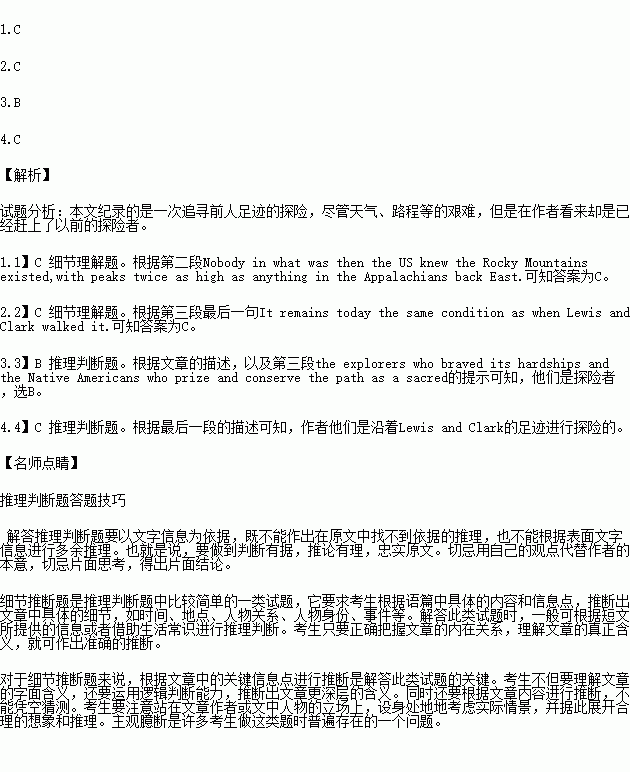题目内容
Grey clouds move as low as smoke over the treetops at Lolo Pass. The ground is white. The day is June 10.It has been snowing for the past four days in the Bitterroot Mountains.Wayne Fairchild is getting worried about our trek over the Lolo Trail-95 miles from Lolo Montana to Weippe in Idaho, across the roughest country in the West. Lewis and Clark were nearly defeated 200 years ago by snowstorms on the Lolo.Today Fairchild is nervously checking the weather reports.He has agreed to take me across the toughest,middle section of the trail.
When Lewis climbed on top of Lemhi Pass,140 miles south of Missoula,on Aug.12,1805,he was astonished by what was in front of him;“high mountain chains still to the West of us with their tops partially covered with snow.”Nobody in what was then the US knew the Rocky Mountains existed,with peaks twice as high as anything in the Appalachians back East.
Today their pathway through those mountains holds more attraction than any other ground over which they traveled,for its raw wilderness is an evidence to the character of two cultures:the explorers who braved its hardships and the Native Americans who prize and conserve the path as a sacred (神圣的)gift. It remains today the same condition as when Lewis and Clark walked it.
The Lolo is passable only from July to mid-September.Our luck is holding with the weather,although the snow keeps getting deeper.As we climb to Indian Post Office,the highest point on the trail at 7,033 ft,we have covered 13 miles in soft snow,and we hardly have enough energy to make dinner.After a meal of chicken,I sit on a rock on top of the ridge (山脊).There is no light visible in any direction,not even another campfire.For four days we do not see another human being.We are occupied with the things that mix fear with joy.In our imagination we have finally caught up with Lewis and Clark.
1. We learn from the text that before 1805 .
A.The Rocky Mountains were wholly covered with snow
B.there were no people living in the western part of America
C.no Americans knew of the existence of the Rocky Mountains
D.the Appalachians were the western frontier of the United States
2.We learn from the text that the Lolo Pass .
A.has changed a lot since 1805
B.is the meeting point of three cultures
C.remains much the same as it was 200 years ago
D.now attracts a large number of tourists to visit
3.Judging from the text,Lewis and Clark were most probably .
A.two native Indians
B.explorers of the early 19th century
C.merchants who did business with the Indians
D.travelers whose curiosity took them over the Lolo Pass
4.We can infer from the text that when crossing the Lolo Pass the author .
A.was attempting the impossible
B.was trying to set a world record
C.was following the trail of Lewis and Clark
D.was fighting with weather and taking unnecessary risks
 津桥教育计算小状元系列答案
津桥教育计算小状元系列答案
